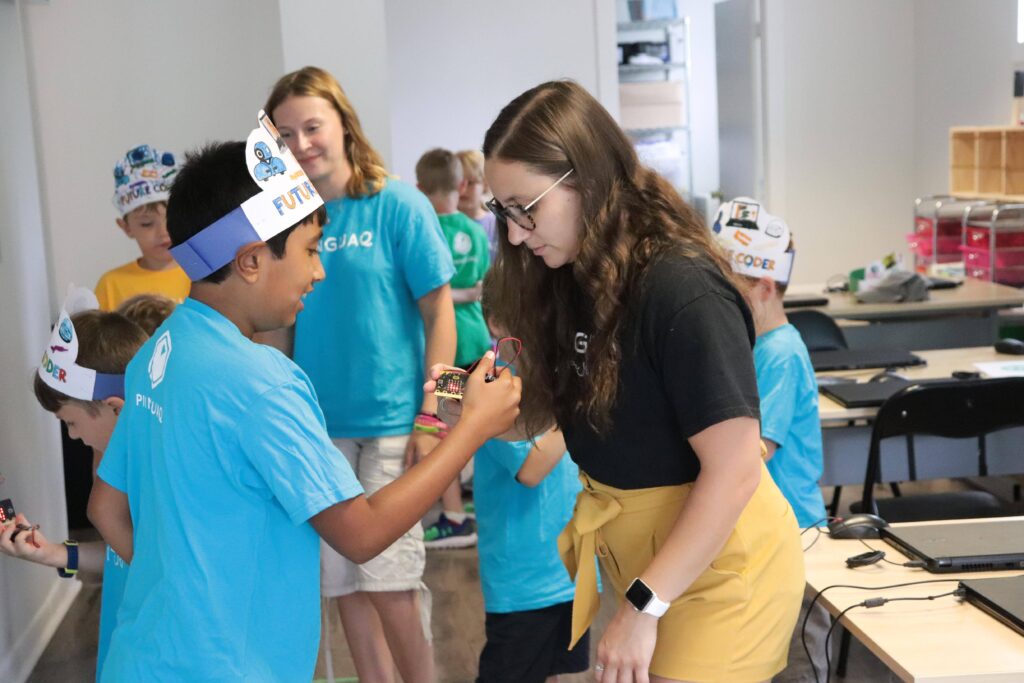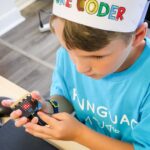At a glance:
- Micro:bits are programmable handheld devices that make coding fun for learners of all ages. They’re ideal for developing STEAM skills through play.
- Communities and learners can use micro:bits to answer questions that matter to them, making the devices highly useful for people in rural, remote and Indigenous communities.
- With the original Learn on the Land Kit, Pinnguaq used micro:bits to play games focused on climate change and as a tool for monitoring their environment with activities such as counting different local species. We’re always exploring new, fun ways to use micro:bits to introduce learners to STEAM!
Coding can seem abstract, but the 9000 micro:bits recently received by Pinnguaq through a partnership with Digital Moment will be used to bring coding into the real world, and to help learners see and realize their own power and potential.
Micro:bits are a fun introduction to coding for people of all ages – as innovative tools that can be used to address real-world challenges, micro:bits can also be programmed to play games, write messages or display smiley faces, making them a great way for kids to build coding skills. They’re compact and programmable with near limitless opportunities for education and exploration, making them an ideal tool for the Pinnguaq team to support the development of STEAM skills through play.

Mary McDonald, Community Delivery Partnership Manager for Pinnguaq, says the tools have become an important part of Pinnguaq’s educational initiatives as well as resources for learners. Both of these – Education and Resources – are part of our Lifecycle, a unique approach to supporting learners at every stage of their journey.
McDonald says micro:bits also connect with the Mentorship element of the Lifecycle as we embrace the train-the-trainer approach. Often a Pinnguaq team member will teach someone how to use the devices and that individual will then continue sharing that knowledge with others. Equipped with the knowledge of how to teach others about programming the devices, communities can continue learning with micro:bits long after their initial introduction.
More specifically, communities can use the micro:bits to satisfy their curiosity about things that are important to them. One person may use their devices to count certain species in their region. Another may be more interested in tracking changes in light levels as they study how it impacts wildlife. Another may just want to play Rock, Paper, Scissors with a digital twist.
“It’s a physical piece that brings coding to life off of the screen, away from the computer. I also love that it can be so many different things. It’s a tool but it’s not just one thing. It can do what I want it to do and it can do what someone else wants it to do. That’s really fun,” says McDonald.
“This is a tool that you can make and take out to the environment. It allows students to have skills and tools to innovate with. With these, they can create solutions that work in their own communities.”
What is a micro:bit and where did it come from?
At its core, the micro:bit is a pocket-sized computer. It is an accessible, simple introduction to how software and hardware work together. With its LED light display, buttons, sensors and other elements, it enables users to practice coding in a tangible way.
The micro:bit was created as part of the BBC’s Make It Digital initiative, launched in 2014. In early 2016, they were distributed to students aged 11-12 across the UK. The Micro:bit Educational Foundation was founded in October of that year with the goal of “bringing digital inspiration” to learners around the globe.
As of February 2023, it was estimated that 39 million students across more than 60 countries had learned with micro:bit. The number of educational micro:bit experiences Pinnguaq has led is estimated to be 5000 and climbing.
According to the Micro:bit Theory of Change, the devices are specifically designed to make learning digital skills fun, relevant and accessible.
What can the micro:bit do?

In addition to working as a method for counting or tracking light levels, the micro:bit can be coded to do a vast number of tasks with varying degrees of difficulty. Beginners can program their micro:bits to act as dice, work as step counters, interact with Scratch games, or measure sound. For those looking for more advanced activities, the devices can be coded as proximity beacons, alarms, timers and more.
Pinnguaq is focused less on what technology can do for a learner and more on what learners can do with the technology. When it comes to using micro:bits, that means sharing knowledge about the capabilities of the tech and working alongside communities to develop strategies to use the devices in ways meaningful to them.
With the original Learn on the Land kit, initially shared with communities in Nunavut, users were invited to play a micro:bit Dice and Race for Change game, exploring issues surrounding climate change, and a Spot the Species Counter activity, encouraging learners to consider the wildlife in their local habitat.
“There’s so many different things you can do with it, making it relevant and impactful for specific communities and their curiosities,” explains McDonald.
9000 micro:bits, one goal
In November, we received a shipment of 9000 new micro:bits, thanks to Digital Moment, a Montreal-based charity working to build a better future through digital literacy education.
Whether they’re going to Treaty 4 as part of a partnership, being used for Makerspace in a Box programming or being delivered to educators the Pinnguaq team recently met through Indspire, the new micro:bits will help learners understand the power of coding, but also that they have the power to use code to create.
“In a nutshell, we’ll be using these as we continue codesigning with partners to create more STEAM experiences where learners can see themselves,” says McDonald.
“Seeing yourself in STEAM is absolutely critical to bringing people in. A micro:bit is one of the tools we can use that welcome learners, all learners, and allow themselves to see themselves reflected.”
